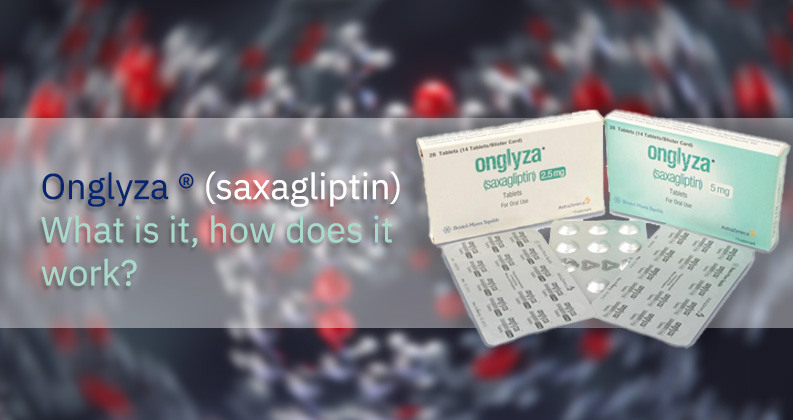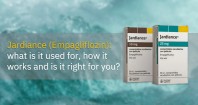
If you have type 2 diabetes, you may be prescribed Onglyza (Saxagliptin) to help control your blood sugar levels. This medication works by inhibiting the DPP-4 enzyme, which helps to keep incretin hormones at higher levels and promotes insulin release after eating. While Onglyza is an effective treatment option, it is essential to be aware of potential side effects and interactions before starting this medication.
What is Onglyza (Saxagliptin) used for?
Onglyza, generically known as saxagliptin, is an oral anti-diabetic drug that inhibits the DPP4 enzyme. It is prescribed to people with type 2 diabetes alone or in combination with other medications.
Onglyza (saxagliptin) acts by blocking the action of dipeptidyl peptidase 4 (DPP-4), which breaks down incretin hormones. When these hormones are released into your bloodstream after eating a meal, they prompt your pancreas to release more insulin, lowering blood sugar levels. By preventing DPP-4 from breaking down these hormones in your body, Onglyza helps keep them at higher levels and helps control blood sugar levels for up to 24 hours after a meal.
It is important to note that Onglyza is not a substitute for insulin. It should not be used to treat type 1 diabetes (insulin-dependent) or diabetic ketoacidosis, a severe condition caused by high blood sugar levels and low insulin levels in your body. Onglyza can also cause a disease called pancreatitis.
Does Onglyza (Saxagliptin) come in a generic form?
As a prescription medication, Onglyza does not come in a generic form. This means that the price of this drug will be high even with insurance coverage.
The FDA has approved no generic versions of Onglyza as of February 2019. However, some or all forms of Onglyza may become available as generic saxagliptin after November 2028, depending on FDA approval and patent expiration. It is important to note that fraudulent online pharmacies may attempt to sell an illegal generic version of Onglyza. These medications may be counterfeit and potentially unsafe.
Commonly prescribed alternative drugs include Actoplus Met, Byetta, and Victoza. These alternatives may be more cost-effective than Onglyza. In some cases, they may even work better for you. Before changing your treatment plan or trying a new medication, you must speak with your doctor about any health risks.
How is Onglyza (Saxagliptin) dosed?
ONGLYZA is taken once a day, with or without food. The recommended dosage is 2.5 mg or 5 mg once daily. ONGLYZA tablets must not be split or cut. Taking more than one tablet in 24 hours can lead to unwanted side effects and complications. Talk to your doctor about dosage adjustments if you have trouble managing your blood sugar with this medication.
How does Onglyza (Saxagliptin) work?
Onglyza (Saxagliptin) is a DPP-4 inhibitor. It works by decreasing the amount of sugar your liver makes after eating and increasing the number of natural substances called incretins that help control blood sugar levels by increasing insulin release, especially after a meal.
This medication has been shown to help lower blood sugar. It can be used alone or in combination with other medicines if diet and exercise are not enough to control your diabetes.
Can Onglyza (Saxagliptin) be used alone or with other medications?
ONGLYZA can be used alone or in combination with other anti-diabetes drugs. Saxagliptin is combined with metformin, sulfonylurea (e.g., gliclazide, glyburide), or insulin to improve blood sugar levels in adults with type 2 diabetes.
● Talk with your doctor or pharmacist about all your diabetes medication(s). You may need to change how much of each drug you take so that you don't get too much or too little medicine over time.*
● Side effects may happen if this drug is prescribed with other diabetes medications. Talk with your doctor or pharmacist about all your diabetes medication(s).
What interactions should you avoid when taking Onglyza (Saxagliptin)
Saxagliptin has been shown to interact with grapefruit. This can affect how the medication works, so it's important to tell your doctor about any unusual symptoms. Saxagliptin may also be affected by some other medications you are taking or any supplements you are using. You should follow your doctor's instructions about food, beverages, or activity restrictions before taking Onglyza (Saxagliptin).
Alcohol may affect blood glucose levels in patients with diabetes. Saxagliptin can also make it more difficult to control your diabetes if you drink too much alcohol. You should talk to your doctor about this if it becomes a problem.
What are the common side effects of Onglyza (Saxagliptin)?
When considering Onglyza (Saxagliptin), it is important to be aware of the potential side effects. The most common side effects include headaches, low blood sugar, and muscle pain. Other less common side effects include runny or stuffy nose, sore throat, cough, stomach pain, upper respiratory tract infection, and urinary tract infection. You must contact your doctor immediately if you experience any of these side effects.
What are the severe side effects of Onglyza (Saxagliptin)?
You should know that ONGLYZA can cause pancreas inflammation (pancreatitis). Stop taking ONGLYZA and contact your doctor right away if you have pain in your stomach area (abdomen) that is severe and will not go away.
Serious side effects can happen in people who take ONGLYZA, including heart failure. Before taking ONGLYZA, tell your doctor if you have had heart failure or kidney problems.
Severe allergic reactions can occur as possible side effects of ONGLYZA.
What happens when I stop taking Onglyza (Saxagliptin) suddenly?
If you suddenly stop taking Onglyza (Saxagliptin), your glucose levels may increase. This can lead to serious health issues. Talk to your doctor before stopping the medication and ensure you understand how to take it properly.
How much does Onglyza (Saxagliptin) cost?
If you're one of the millions of Americans living with diabetes, you know that the cost of treatment can be a significant burden. Onglyza (Saxagliptin) is a prescription medication, and a 30-day supply can cost upwards of $500. However, many insurance plans cover the cost of Onglyza (Saxagliptin), with co-pays ranging from $32.50 to $55.00.
If you're paying for Onglyza (Saxagliptin) out-of-pocket, there are a few ways to save.
● Check with your pharmacist to see if there are any generic options available, and be sure to ask about any coupons or discounts that may be available.
● You can also check websites like Global Pharmacy Plus for discounted imported versions of Onglyza.
● With a little bit of research, you can find ways to save on the cost of Onglyza (Saxagliptin) and keep your diabetes under control.
Conclusion
If you live with type 2 diabetes, Onglyza (Saxagliptin) can be an effective treatment option for controlling your blood sugar levels. It is essential to discuss all of your concerns with your doctor before starting any new medication.







